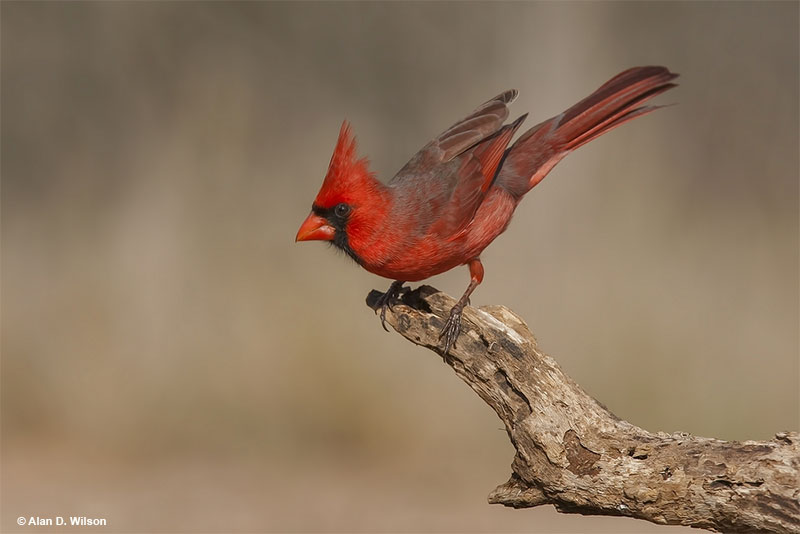
Virginia is a medium-sized state with a population of 8,683,619. Located south of Maryland, the eastern border of Virginia includes the Chesapeake Bay while the Blue Ridge Mountains define the western part of the state. There are 42,774.2 square miles of coastal marshes, woodlands, montane forests, fields, and farmlands in Virginia.
This variety of habitats hosts many birds and has resulted in 487 species on the official birds of Virginia list. This impressive number is more than most other states and places Virginia among the top 15 states with the highest number of bird species in the nation.
On this page
Most Common Birds of Virginia
According to Breeding Bird Surveys in 2021, in Virginia, volunteers counted 25,246 birds of 137 species. See the 20 most commonly counted species below, along with the woodpeckers, hawks, owls, eagles, and hummingbirds of Virginia.
American Crow

© Alan D. Wilson
Scientific name: Corvus brachyrhynchos
Length: 17.5 inches
Weight: 1 pound
Wingspan: 39 inches
Song: “Caw! Caw!”
The American Crow is a large, all black bird with long, broad wings and a broad tail. Both sexes look alike and have a stout, black bill. With a close look, we can see that the beak has a small, hooked tip and that feathers extend onto the top part of the bill.
In certain lighting, we also see dark purple and blue iridescence on American Crows.
In most places, it’s pretty easy to identify these big, social birds. However, in coastal areas, they can occur with the nearly identical Fish Crow. In those places, the best way to identify them is by their calls. Luckily, crows have a hard time staying quiet.
American Crows are one of the most common birds of Virginia.
American Crows can also be confused with the Common Raven but that species is bigger, has a wedge-shaped tail, and makes a deep, croaking sound.
Key Identifications:
- Big, all black bird with long, broad wing and a broad tail.
- Forages for carrion, fruit, seeds, insects, and small animals.
- Builds a bulky stick nest high in a tree.
- American Crows are very vocal birds. They can make several calls but their most common one is, “Caw! Caw! Caw!”
Red-eyed Vireo
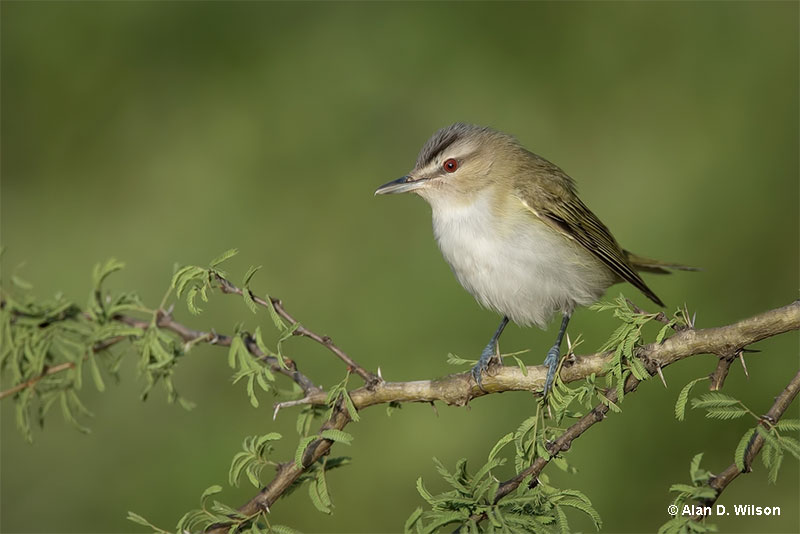
© Alan D. Wilson
The Red-eyed Vireo is a small songbird that is olive green above and white below. Males and female of this plain bird look similar and have a gray crown with a small black border and a pale eyebrow. They also have a dark line passing through a reddish eye.
These features help identify this bird in most parts of its range. Like other vireos, they also have a rather thick bill with a small, hooked tip.
These small birds spend most of their time foraging for larvae and insects in the foliage of deciduous trees. They take their time as they move through branches, carefully checking on and under leaves for their food.
Male Red-eyed Vireos love to sing. In spring and summer, the short phrases of this little bird are a constant feature of woodlands and forests throughout their range. As they sing high overhead, we often hear them singing but they can be hard to see.
European Starling
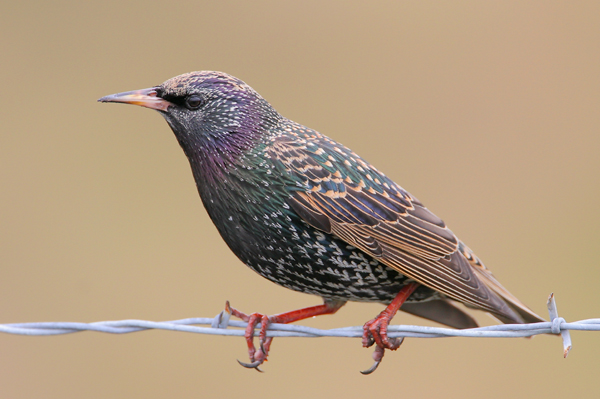
Photograph © Greg Lavaty.
The European Starling is a chunky black bird with a longish sharp beak, short tail, and long wings. In summer, starlings are glossy black with purple and blue metallic highlights, have some small white spots, and yellowish beaks.
In winter, they are duller, are heavily spotted with white, have a black beak, and reddish-brown in their wings. Young birds are mostly gray with a pale throat.
They are around the same size as a Red-winged Blackbird and sometimes flock with this and other blackbird species. European Starlings forage for insects and seeds in farm fields, lawns, and other habitats with open ground. They also nest in tree cavities and compete with other, native bird species over nest sites.
European Starlings are common birds in Virginia. They are easily identified by their dark plumage with white spots. In flight, their chunky shape and long wings also stand out.
Northern Cardinal
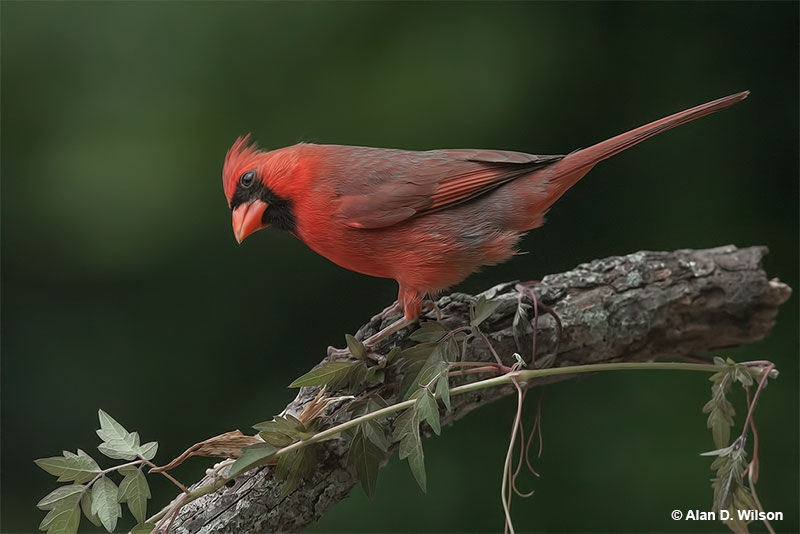
Scientific name: Cardinalis cardinalis
Length: 8.75 inches
Weight: 1.6 ounces
Wingspan: 12 inches
Song: “pichew-pichew-pichew, chew,chew,chew,chew,chew”
The Northern Cardinal is a medium-sized songbird with a perky crest and a thick, orange-red beak. Males are bright red with black on the face and throat, and are duller red on the wings, back, and tail.
Females are shaped like males and share the red-orange beak but are duller gray-brown and buff. However, their plain colors are highlighted by a bit of red in the crest, wings, and tail.
Northern Cardinals also have short, rounded wings, and a longish, rounded tail. These features are especially visible when they fly between feeders and bushes and trees.
The Northern Cardinal is a bird of gardens, second growth, and forest edge. In most parts of its range, it is a common bird that visits feeders and forages on the ground and in low vegetation. It eats seeds, insects, and some berries.
Is the Northern Cardinal the state bird of any states?
Northern Cardinal happens to be a state bird for 7 states: Virginia, Illinois, Indiana, Kentucky, North Carolina, Ohio, and West Virginia
Key Identifications:
- Crested bird with a conical orange-red beak and a black face. Males are red, females are grayish-brown and buff.
- Forages for seeds and insects on and near the ground.
- Makes a cup-shaped nest in bushes and low trees.
- Sings a clear, whistled song of repeated notes. They can sound like “cheer, cheer, chew, chew, chew, chew” or a quick “birdee,birdee,birdee,birdee,birdee“. They also make loud, sharp chip notes.
Carolina Wren
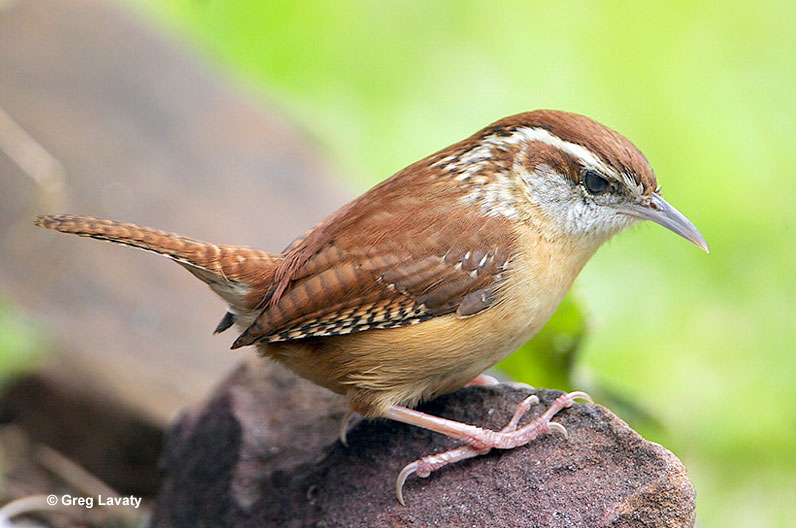
Scientific name: Thryothorus ludovicianus
Length: 5.5 inches
Weight: .74 ounces
Wingspan: 7.5 inches
Song: “teakettle, teakettle, teakettle”
The Carolina Wren is a small to medium-sized songbird that is reddish-brown above and rich buff below. It has a white throat, a long, narrow white eyebrow, and a mottled white face. Both sexes look alike and have a long, sharp, slightly curved beak, and black barring in the wings, tail, and under the tail. They also have some small white markings in the wings and tail.
Pairs of this curious little bird forage for insects in vine tangles, gardens, and second growth. As they search dead leaves and other vegetation for choice bugs, they hold their tail slightly cocked up.
Carolina Wrens are very vocal birds. They often give a loud song that sounds like, “Teakettle, Teakettle, Teakettle”.
This species is a common bird of woodlands and second growth in most parts of its range. They rarely flock with other birds but will help other species harass snakes and other possible threats.
Key Identifications:
- Small reddish-brown and buff bird with a long beak and long white eyebrow.
- Feeds on arthropods in dense, tangled vegetation.
- Makes a domed cup nest with a side entrance in crevices, tree cavities, and human-made structures.
- Carolina Wrens fill the garden with loud and melodious songs. One common song sounds like, “teakettle, teakettle, teakettle“. They also make trilled sounds and harsh, nasal calls.
Mourning Dove
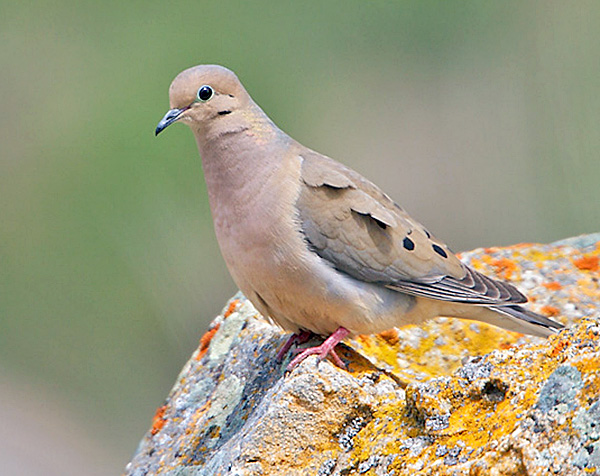
Photograph © Greg Lavaty.
Scientific name: Zenaida macroura
Length: 12 inches
Weight: 4.2 ounces
Wingspan: 18 inches
Song: “hooOOA, hoo, hoo, hoo”
The Mourning Dove is a pleasant pale brown and gray dove with a long, pointed tail and some black spots in its wings. It is more buff-brown on the belly and under the tail, has a small head, small dark beak, and a narrow blue-gray eyering.
In flight, we can also see white and black on the outer tail feathers. Both sexes have a small black mark on the face and a patch of yellowish iridescence on each side of the neck. They look very similar but male Mourning Doves have more gray on the head and more iridescence.
Mourning Doves forage for seeds and grain on the ground but also visit feeders. This common bird can also occur in small flocks as they forage in farmlands, parks, and other open habitats.
No other dove in their range has a long, pointed tail and mostly uniform brown wings. We hear their mournful calls in towns, woodlands, and many other habitats.
Key Identifications:
- Plain brown and gray dove with a long, pointed tail.
- Feeds on seeds at feeders and on the ground in open areas.
- Makes a small, messy nest of sticks in trees.
- Sings a sad and owl-like “hooOOA, hoo, hoo, hoo”.
Indigo Bunting
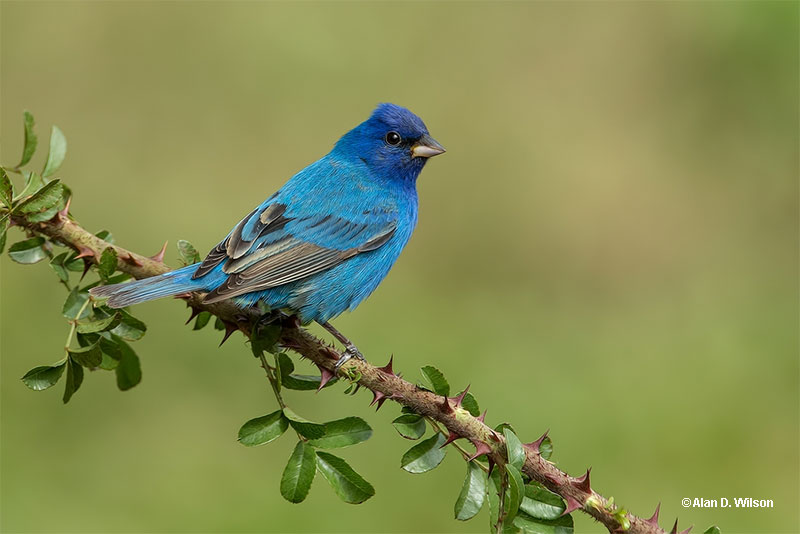
© Alan D. Wilson
The Indigo Bunting is a small, sparrow-like bird with a slender, conical bill. Males are unmistakable and have dark, sapphire blue plumage with black in the wings, on the face, and in the tail. Depending on the lighting, their blue colors can appear darker, paler, or entirely black.
Female Indigo Buntings are plain, pale brown birds with a hint of blue on the rump and tail, and some brown streaks on pale underparts. They can also have brown wing bars and have a buff eyering. Females have a paler beak than the male but both sexes can show a short crest.
In fall, male Indigo Buntings look more like females but still have some blue in parts of their plumage.
This species feeds on seeds and insects in low, brushy vegetation. In summer, Indigo Buntings are common birds of brushy second growth. In fall, they migrate south for the winter.
Chipping Sparrow
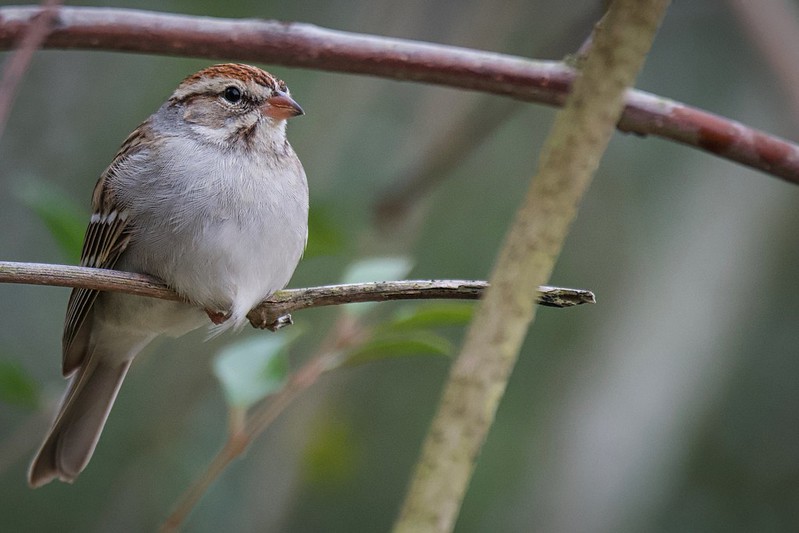
© Kevin Milazzo
The Chipping Sparrow is a small, gray and brown sparrow with a slender, slightly forked tail and a small conical bill. In summer, we can recognize this species by its rufous cap, white eyebrow, and dark line through the eye.
Both sexes look alike and also have small white crescents above and below the eyes, dark streaks on a pale brown back, gray rump and underparts, and pale brown wings with two pale wing bars.
In fall, Chipping Sparrows lose the rufous cap and have brown and buff on their faces. They can look very similar to the Clay-colored Sparrow but always have a gray rump and a dark line through the eye. They are one of the most common birds of Virginia.
This species forages on the ground for small seeds and insects in open, grassy areas near pines and other conifers. Chipping Sparrows are especially common in parks and on golf courses. They migrate south for the winter.
Common Grackle
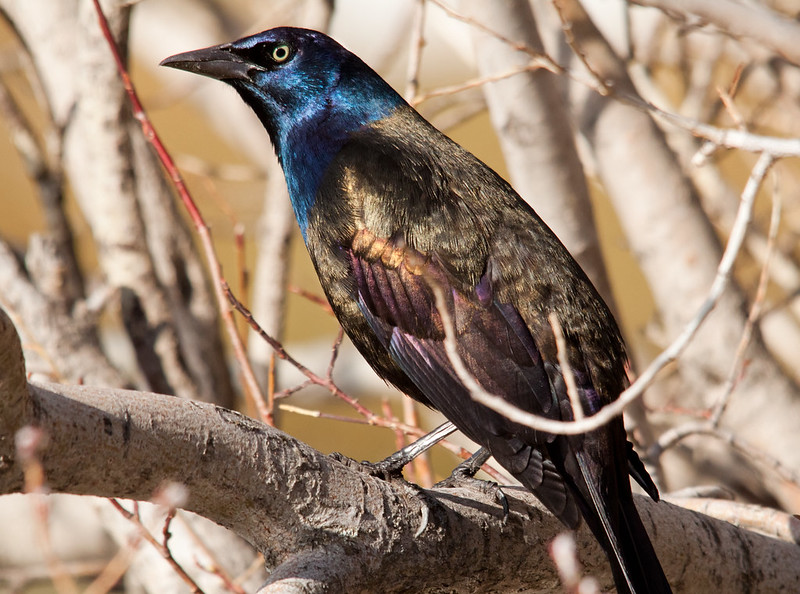
© Shawn McCready
Scientific name: Quiscalus quiscula
Length: 12.5 inches
Weight: 4 ounces
Wingspan: 17 inches
Song: “Sherink!”
The Common Grackle is a fairly large blackbird with pale yellow eyes, glossy black plumage, and a long, wedge-shaped tail. In certain lighting it shows blue, purple, bronze, and green metallic highlights!
Male and female grackles look very similar but females have shorter tails and aren’t as iridescent as the males.
Both sexes also have strong sharp beaks. These omnivores use their hefty beaks to eat a variety of food items including insects, seeds, grain, garbage, and worms and other small animals.
Most food is caught on the ground and they can even wade in shallow water to catch small fish and other aquatic creatures. During nesting season, Common Grackles also attack the eggs and nestlings of other birds.
Common Grackles frequent parks, towns, wetlands, and other open and semi-open habitats. They sometimes visit feeders and are very social birds that form large flocks, especially during the winter.
Key Identifications:
- Fairly large, black bird with glossy purple, greenish, bronze, or dark blue highlights. It also has pale eyes and a long, wedge-shaped tail.
- Forages for insects, seeds, and other food on the ground in a variety of open habitats.
- Constructs a bulky cup nest in a conifer.
- Common Grackles are vocal birds. They frequently give raspy, metallic calls, “Sherink!”, and “kek” calls.
American Robin
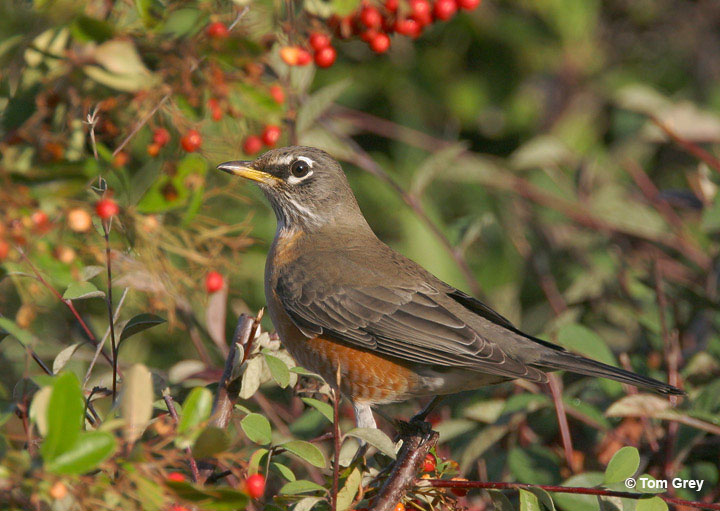
© Tom Grey
The American Robin is a large thrush with an orange-yellow beak and brick-red underparts. It is also dark gray above and has a blackish head and tail. This species has small white marks around the eyes, white streaks on the throat, and white on the belly and undertail.
American Robins also have frosty edging to the feathers in their long wings. Females resemble males but are duller overall and have some small white markings on their underparts. Juvenile birds are paler and heavily spotted below.
In spring and summer, the American Robin mostly feeds on worms and other insects. It catches them by foraging on lawns and other areas with open ground and then quickly bending down to snatch the food with its bill.
In winter, American Robins mostly feed on fruits and berries. At this time of year, they flock together and wander in search of fruiting trees. This species lives in a wide variety of habitats.
Tufted Titmouse
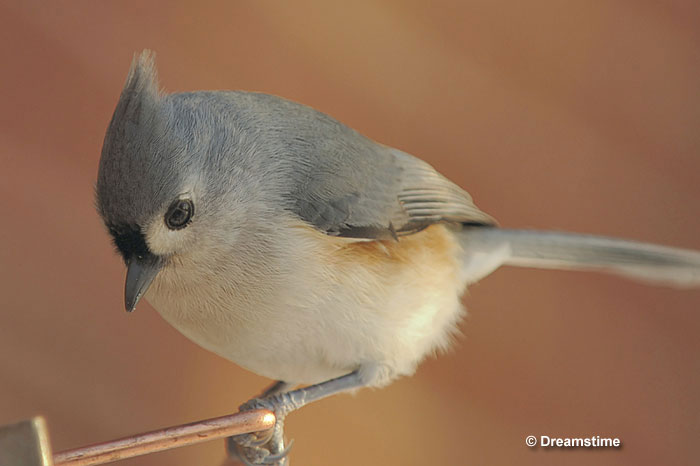
Scientific name: Baeolophus bicolor
Length: 6.5 inches
Weight: .75 ounces
Wingspan: 9.75 inches
Song: “peter peter peter”
The Tufted Titmouse is a small, crested bird with a black mark above its stubby black beak. It has plain, blue-gray upperparts and is white below with a burnt-orange patch on its flanks. With its beady black eye on a white face, this species has an undeniably cute look!
Males and females of this fun little bird look alike, and no other bird in their range looks remotely similar. They often form small groups that forage together and with other small birds in woodlands, parks, and gardens.
The Tufted Titmouse mostly feeds on seeds, nuts, and insects. This unique little bird adds an adorable touch to feeders and also forages on branches, twigs, and in foliage. They are one of the most common birds of Virginia.
The constant calls of the Tufted Titmouse alert us to their presence in the neighborhood. They whistle over and over, “Peter, Peter, Peter”. It may prefer oak woodlands but is a common permanent resident in most parts of its range.
Key Identifications:
- Small, crested blue-gray bird with pale underparts and a white face.
- Feeds on seeds and insects and visits feeders.
- Nests in tree cavities and nest boxes.
- The Tufted Titmouse is a very vocal bird. It gives constant whistled calls over and over, “peter peter peter“.
Northern Mockingbird
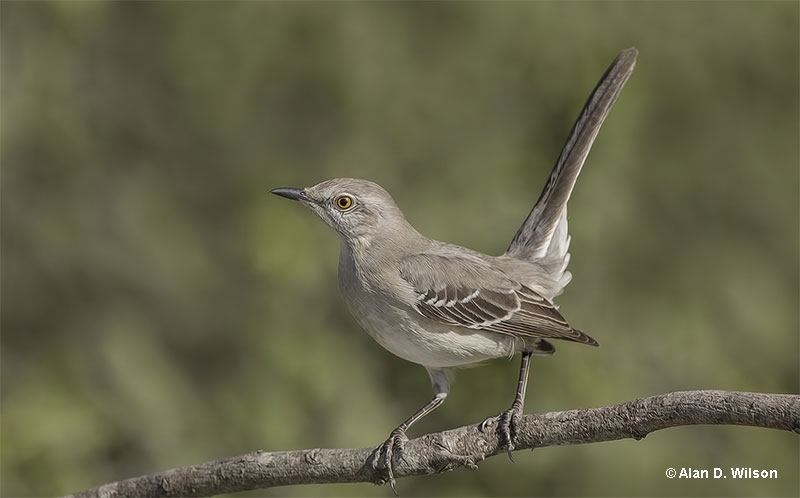
© Alan D. Wilson
Scientific name: Mimus polyglottos
Length: 10 inches
Weight: 1.7 ounces
Wingspan: 14 inches
Song: “kerdee, kerdee, kerdee…jirdle,jirdle,jidrle…”
The Northern Mockingbird is a pale gray, slender bird with a long tail and a short, slightly curved beak. About the same size as an American Robin, Northern Mockingbirds have a dark line through a pale eye, and are pale gray above and white and buff below.
Males and females look the same and have white markings in the wings and in the tail. Young birds have some paler brown colors and a paler bill.
This species feeds on insects and fruits. It forages for insects by standing on open grassy habitats and then running to snatch the small creature with its beak. They can also fly into the air to catch insects in flight.
In winter, berries make up a large part of the Northern Mockingbird diet. They take these items while perched in bushes and trees. This vocal species is commonly seen in parks, towns, and other open habitats.
Northern Mockingbirds are one of the most common birds of Virginia.
Key Identifications:
- Vocal, gray and white bird with a small bill, white wing patches, and a long, black and white tail.
- Feeds on the ground in open areas and in bushes. Mostly eats insects and berries.
- Makes a cup nest in a bush or low tree.
- Very vocal. Sings many phrases and mimics many other birds. Some of the more regular phrases sound like, “kerdee, kerdee, kerdee…jirdle,jirdle,jidrle…“. These are interspered with the calls of Blue Jays, woodpeckers, Tufted Titmouse, and various other bird species.
Eastern Bluebird
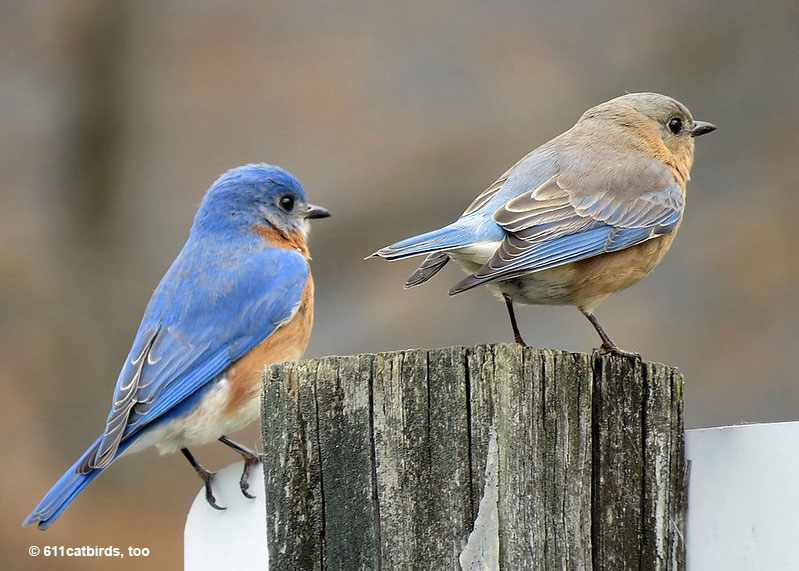
© 611catbirds, too
The Eastern Bluebird is a smallish bird a bit larger than a sparrow but smaller than an American Robin. Males are a brilliant bright blue above and reddish-orange on the throat, breast, and flanks. The rest of their underparts are white.
Female Eastern Bluebirds are like males but have gray instead of bright blue and paler blue highlights in the wings and tail. They also have white bordering the back part of their eyes.
Both sexes have some black in their long wings and a short, mostly dark bill.
Eastern Bluebirds feed on insects and berries. In summer, they forage for insects in open, grassy areas by waiting on a perch or hovering and then catching the insect on the ground. In winter, they form flocks that wander in search of fruiting trees.
This species needs tree cavities for nesting. Fortunately, nesting boxes placed on “Bluebird trails” have helped this beautiful little bird increase in many places.
Ovenbird
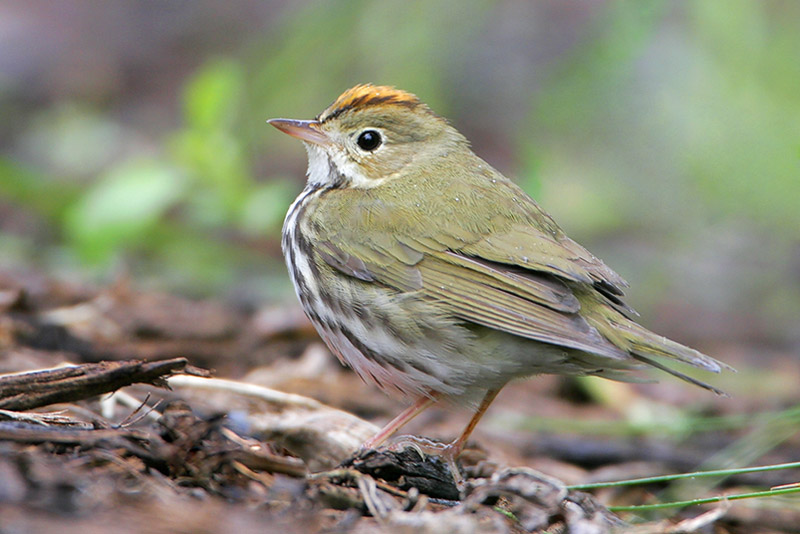
The Ovenbird is a sparrow-sized warbler with a small, pale bill. It is olive above and white below with dark streaks on its breast and flanks. Both sexes look alike and have an orange stripe with dark borders on the top of their head.
They also have a pale eyering, a dark mark on each side of the throat, and pink legs. This warbler looks a bit like the Hermit Thrush and other spotted thrush species but can be recognized by the orange stripe on its head, and its olive upperparts.
Ovenbirds feed on arthropods. They walk on the ground with their tails cocked up and pick food items from the ground and low vegetation.
Ovenbirds spend the summer in forest and migrate south for the winter. The presence of this unique little bird is usually revealed by its loud and repetitive song. It says, “teacher,teacher,Teacher,TEACHER!”.
Red-winged Blackbird
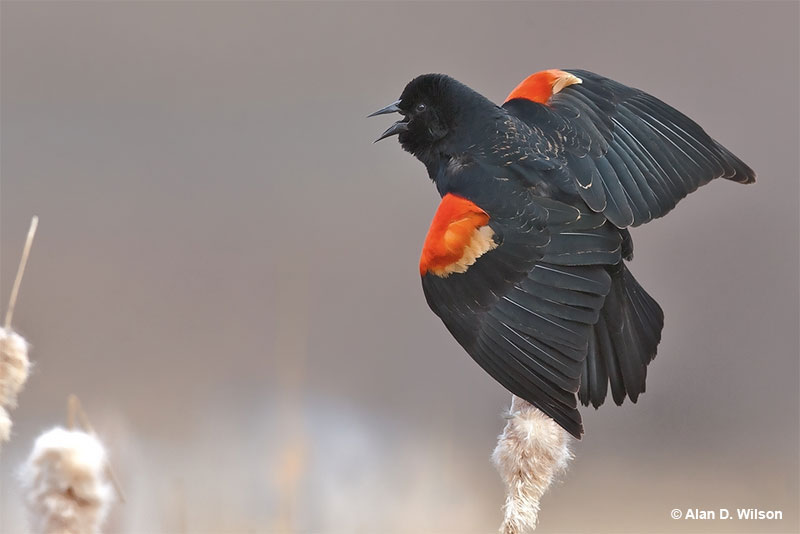
Scientific name: Agelaius phoeniceus
Length: 8.75 inches
Weight: 1.8 ounces
Wingspan: 13 inches
Song: “kan-keree!”
The Red-winged Blackbird is a medium-sized bird with a sharp, black beak, and medium-length, rounded tail. Males have black plumage with bright red shoulders on their wings. They showcase these red patches with narrow yellow borders while displaying to females in spring and summer.
Female Red-winged Blackbirds are dark brown-gray, streaked birds with some reddish-brown markings above, and buff on the throat and face.
No other bird in eastern North America has the red wing patches like this species. Females are also easily recognized by their heavy streaking, sharp black bill, and buff markings on their face and throat.
Red-winged Blackbirds feed on insects, seeds, and grain. They forage by walking on the ground and picking up food items with their bills. These common, social birds can also eat seed at feeders and form large flocks in winter. We see them in wetlands, farm fields, parks, brushy fields, and other habitats.
Key Identifications:
- Males are medium-sized blackbirds with a bright red patch on their wings. Females are heavily streaked, have a sharp black beak, and buff on the head.
- Feeds on seeds, grain, and insects on the ground in many open habitats.
- Builds a cup nest in a bush or other low vegetation.
- Red-winged Blackbirds often call. Males sing a loud, “kan-keree!” and both sexes also make “check!” calls and a high-pitched whistle-like sound.
American Goldfinch

© Alan D. Wilson
The American Goldfinch is a small finch with a pale, conical bill. Males are bright yellow with a black cap, black and white wings, and a short, black and white forked tail. They also have white on the lower belly and under the tail.
Female American Goldfinches are yellowish and have a white belly and undertail. They also have dark wings with buff wing bars and a black and white tail.
In winter, both male and female goldfinches are much duller. Males lack the black cap and are dingy yellow. Females are mostly pale buffy-brown.
American Goldfinches feed on seeds and insects. They forage by perching on thistles and other weedy plants and picking out the seeds with their bills. They are also frequent visitors to feeders.
The American Goldfinch often occurs in small flocks. They prefer weedy fields and other open habitats and are often seen in bounding flight. They are common birds of Virginia
Eastern Wood-Pewee
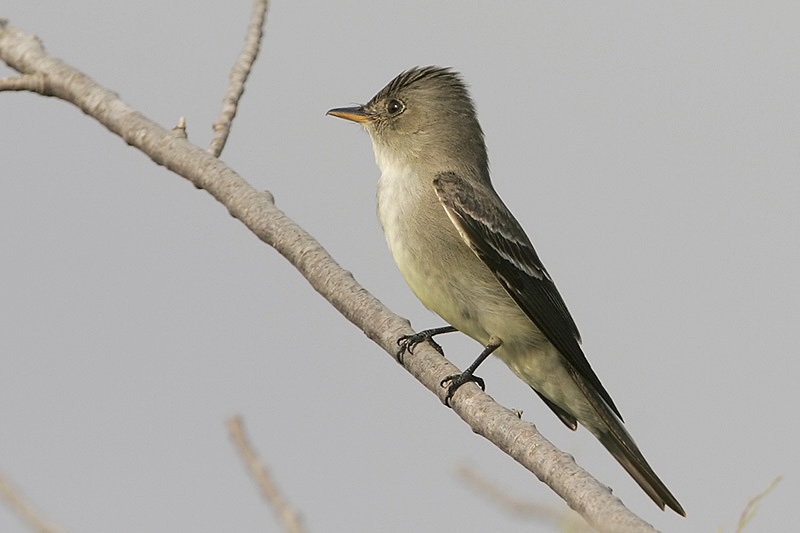
Photograph © Greg Lavaty.
The Eastern Wood-Pewee is a small, plain grayish-brown flycatcher with two pale wing bars and a short crest. Males and females look alike and have long wings with some pale edging on their feathers. They also usually have some pale yellow on the belly and have grayish on the chest and flanks.
These birds look a lot like other small flycatchers with similar plumage patterns. The best way to identify them is to note how long their wings are and hear them call.
Eastern Wood-Pewees are very vocal and say their name, “Pee-o-wee”. They feed on insects and catch them in flight after flying out from a perch. This flycatcher lives in a variety of wooded habitats and is often seen sitting still on a stick or other perch.
These summer residents also have some orange on their beaks and migrate to the Amazon rainforest for the winter.
Barn Swallow
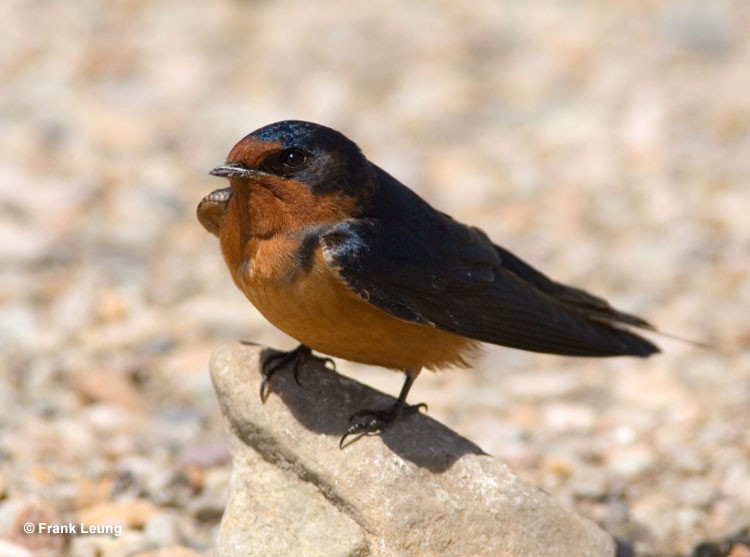
The Barn Swallow is a small, elegant swallow with a long, forked tail. The male has dark, steel-blue upperparts, peach-orange underparts, and is rich, reddish chestnut on the throat and above the bill.
He also has some white spots in the tail. Female and young Barn Swallows look like males but are paler below and on the head, and have shorter tails.
Barn Swallows feed on insects in flight. They forage by swiftly flying low over fields and other open habitats as they catch small insects with their wide-open mouths. After feeding, small flocks may rest on fence wires, roadside cables, or other perches.
This species builds a mud nest and often constructs it on structures such as barns and bridges. In summer, it is common in a variety of open habitats but migrates to South America for the winter. Before and during migration, large numbers can sometimes be seen roosting and flying together.
Eastern Meadowlark
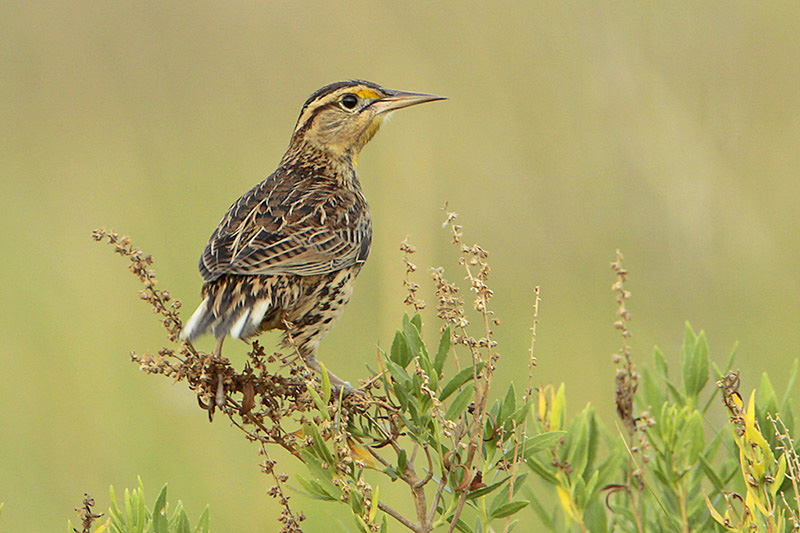
The Eastern Meadowlark is a chunky pale brown and yellow bird of open habitats. Males and females are similar although females tend to be a bit duller. They have pale brown upperparts with dark and white streaks and mottling, and bright yellow underparts with a big, black “V”-shaped mark.
Eastern Meadowlarks also have a white face with a black line going back from the eye, and a yellow and white eyebrow. Their crown is dark brown with a white line down the center and they have streaks on their white flanks.
These birds also have a rather short pale brown tail with dark barring and white outer tail feathers. They use their long, pink legs to walk in open habitats like farm fields and big meadows.
The Eastern Meadowlark feeds on insects and seeds. It picks up food with its long bill while walking on the ground, and often gives its clear whistled song from a low perch.
Wood Thrush
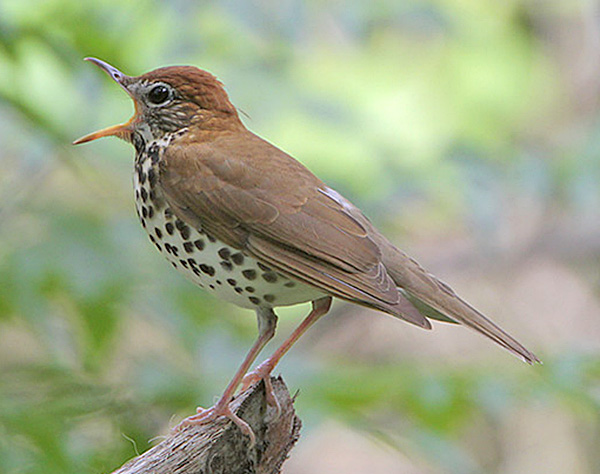
The Wood Thrush is a medium-sized thrush with reddish-brown upperparts and white underparts with black spotting. Male and female birds look alike, and have a hint of a white eyering and black and white mottling on the face.
Wood Thrushes have grayish beaks with a pinkish base, and pink legs and feet. This bird species feeds on insects and other small creatures on the forest floor. It forages by making a few careful hops and then standing still as it looks for insects and worms.
When it spies food, it quickly moves in to catch it with its beak. Wood Thrushes live in mature deciduous and mixed forest. These shy birds can be hard to see but they are very easy to hear. Their ethereal whistled songs are one of the most beautiful sounds of summer.
In fall, the Wood Thrush migrates to tropical forests in Mexico and Central America.
Hawks in Virginia
Red-shouldered Hawk
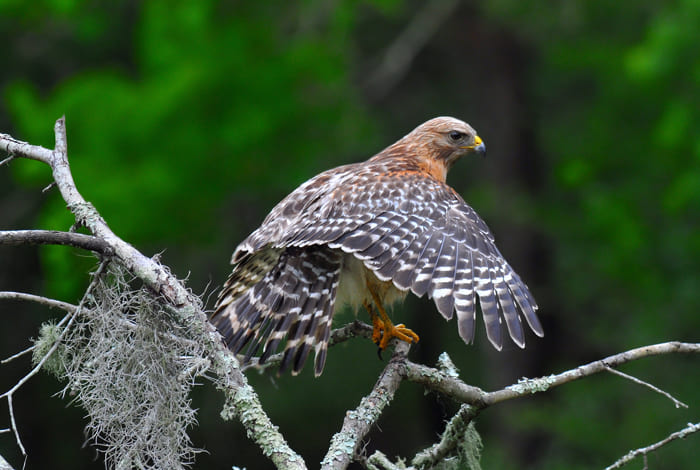
Scientific name: Buteo lineatus
Length: 17 inches
Weight: 1.4 pounds
Wingspan: 40 inches
Song: “Kyeah, Kyeah, Kyeah, Kyeah!”
The Red-shouldered Hawk is a raptor with long, broad wings and a longish, black and white tail. This hawk species is around the same size as a crow and has mottled brown, black, and white upperparts, a reddish brown head, and orange on the breast and underparts.
Both sexes look the same and have reddish-brown shoulders but females are a bit larger than males. Young birds are grayish brown above and have white underparts with dark brown streaks. Like adults, in flight, a pale white mark in the shape of a crescent is visible on their primaries.
This hawk feeds on small mammals, frogs, snakes, and small birds. It catches its prey by swooping down from a perch and seizing it with its talons. Red-shouldered Hawks are often seen soaring over forest habitats in much of their range.
They can live in all sorts of woodlands but may prefer swamps and riparian zones.
Key Identifications:
- Crow-sized, colorful raptor with reddish-orange below and black and white wings and tail.
- Preys on snakes, frogs, and other small animals.
- Builds a bulky nest high in a tree.
- Red-shouldered Hawks are vocal raptors that make loud, jay-like, or even gull-like calls. They often make a repeated sound, “Kyeah, Kyeah, Kyeah, Kyeah!“, and can also make shorter “Kiyip! Kiyip!” calls.
Red-tailed Hawk
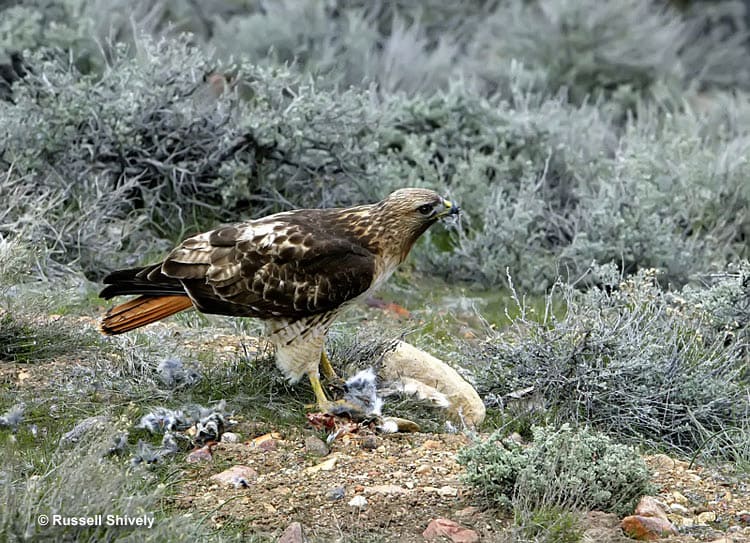
The Red-tailed Hawk is a stocky, big hawk with brown upperparts and a reddish tail. It has white underparts and dark brown markings on its belly. This “belly band” is one of the best ways to quickly separate Red-tailed Hawks from other species.
As with other raptors, males are a bit smaller than females. Young birds are like adults but have brown tails with dark bands and may have more markings on their underparts.
Red-tailed Hawks hunt for a wide variety of small animals. They catch rats, rabbits, squirrels, some birds, and other small creatures after swooping down onto them from a perch or while soaring high overhead.
The Red-tailed Hawk is one of the more common and adaptable hawk species. It lives in habitats as varied as forest, farmlands, and even in cities. Some birds that nest in northern regions migrate south but most are present all year long.
Broad-winged Hawk
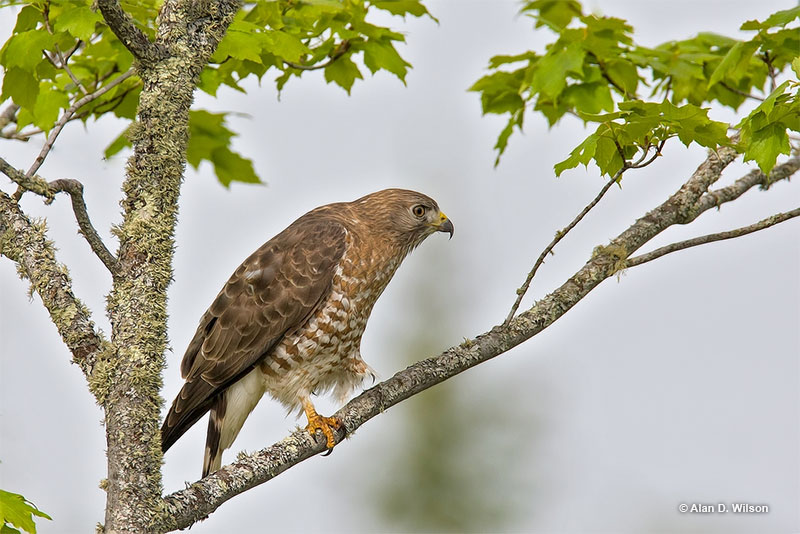
© Alan D. Wilson
The Broad-winged Hawk is a smallish, chunky, crow-sized raptor with mottled brown upperparts and a broad black and white tail. Adults have dark reddish-brown marks and barring on white underparts and a dark mark on each side of their white throat.
Juvenile Broad-winged Hawks are similar but have dark brown streaks below instead of barring. These small hawks feed on insects, small mammals, small snakes, and other small animals. They usually hunt from a perch, watching for prey to come into view and then flying down to catch it with their talons.
Broad-winged Hawks are birds of wooded areas next to meadows and other openings in the forest. They are fairly common in forested areas throughout their range and are often seen soaring above such habitats.
In flight, one good way to tell this bird is by its broad tail with white bands, and wings with a dark trailing edge that are shaped like a “paring knife”.
Cooper’s Hawk
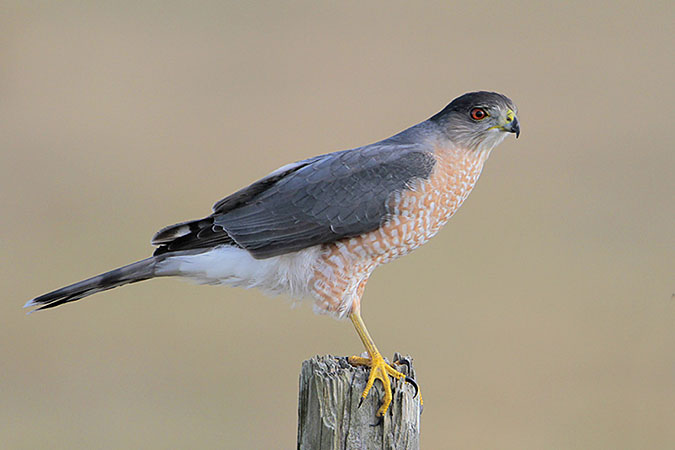
The Cooper’s Hawk is a slender yet powerful raptor nearly as big as a crow. Adults are blue-gray above and have dense orange barring below. They also have mottled orange and white on the face and side of the head.
These raptors have dark bands on long, rounded tails, rather short wings, and often show a dark cap on a slightly crested head. Young birds are shaped like adults but are dark brown above and white below with dark brown streaks.
One of the best ways to tell this species from the similar Sharp-shinned Hawk is by the rounded tail, the head projecting more in flight, and a paler nape.
Cooper’s Hawks fly by alternating a few quick flaps with gliding. They are often seen flying between trees and wooded areas as they hunt for squirrels, Mourning Doves, and other small mammals and medium-sized birds.
The Cooper’s Hawk is common in many urban areas, woodlands, and parks.
Further Reading: Most Common Hawks in Virginia
Owls in Virginia
Barred Owl
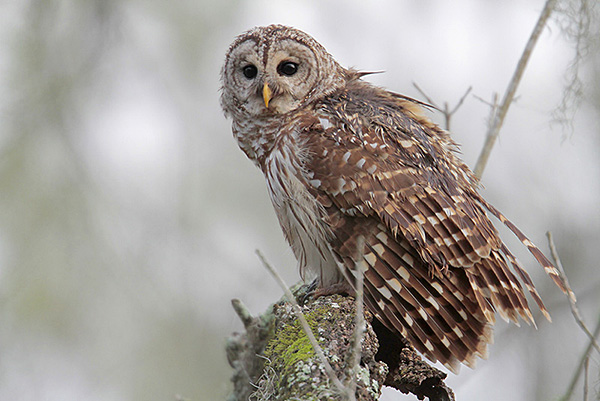
Photograph © Greg Lavaty.
The Barred Owl is a big owl with a round head, large dark eyes, and a pale face bordered with black. It is dark brown above with white spots and markings, and pale gray below with dark brown barring on the breast and dark brown streaks on the rest of the underparts.
This owl species also has long, broad wings and a broad dark brown tail with white bands. Females are bigger than males, and both sexes have a narrow, sharp yellow beak.
Barred Owls feed on squirrels and many other small animals in wooded habitats. These adaptable birds are common in most areas, especially in wooded swamps. In these and other wetlands, they often feed on crayfish and frogs.
Although they are nocturnal, we occasionally see and hear Barred Owls in the day. They give a distinctive and easily imitated, “Who cooks for you!? Who cooks for you all!!”
Eastern Screech-Owl
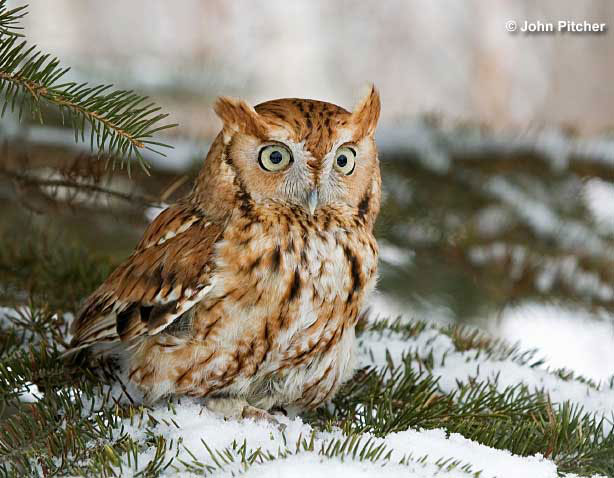
The Eastern Screech-Owl is a small and stocky owl with two feathered “horns”. This common owl can be rich reddish-brown, brown, or mostly gray. Birds with all of these plumages also have white spots where the upper wing meets the back, a pale face with a dark border, and dark streaks and other markings on white underparts.
They also have long, broad wings and dark bands on a broad tail. Eastern Screech-Owls are strictly nocturnal and feed on insects and small animals. They catch their prey by carefully watching and listening and then swooping down into it from a low perch.
Since Eastern Screech-Owls have excellent camouflage, they are rarely seen in the day. Even so, this is a very common owl species that lives in parks and many other wooded habitats. As long as enough big trees are present, at night, their wavering whinny calls and other vocalizations can be heard in towns and many other places.
Great Horned Owl
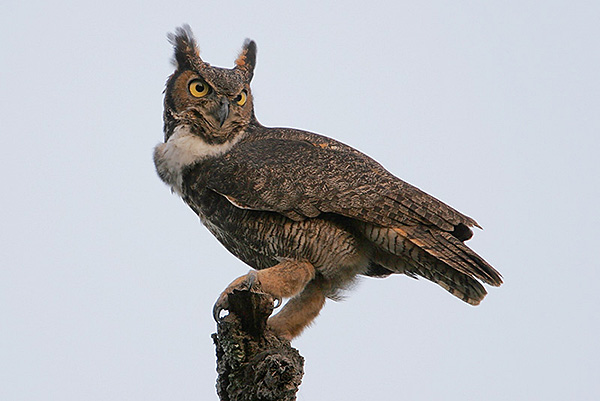
Photographs © Greg Lavaty.
The Great Horned Owl is a big, bulky owl with feathered “horns”, a sharp black beak, and deep yellow eyes. They vary in color but most have a rufous face with a narrow black border, a white patch on the throat, and fine dark barring on mottled gray and brown underparts.
Their upperparts are mottled brown, they have long broad wings, and a broad tail with dark bands. The legs of this species are also covered in brown-orange feathers.
Great Horned Owls are powerful birds that feed on a wide variety of prey items. They can catch small birds, many small mammals, skunks, frogs, and even large birds. This owl is the main predator of hawks and other, smaller owl species!
Great Horned Owls are nocturnal birds that catch their prey in the middle of the night. They do well in many habitats including towns, wetlands, forest, and other places.
Keep reading: Most common owls in Virginia
Woodpeckers in Virginia
Red-bellied Woodpecker
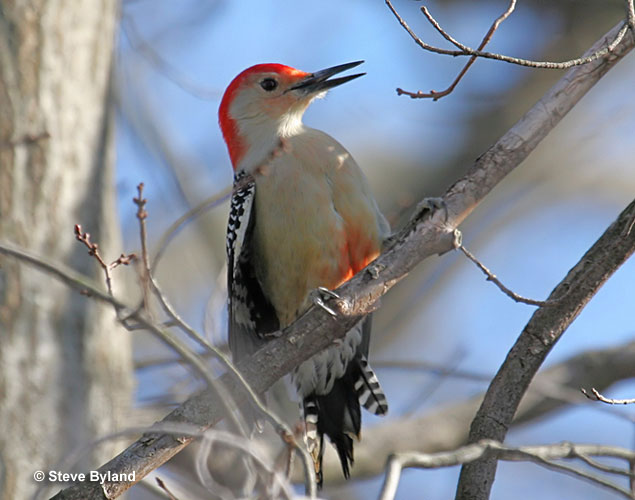
Red-bellied Woodpecker
Scientific name: Melanerpes carolinus
Length: 9.25 inches
Weight: 2.2 ounces
Wingspan: 16 inches
Song: “Qwerr!”
The Red-bellied Woodpecker is a medium-sized woodpecker with black and white barring on its back and wings. It has pale gray underparts with a small red patch on its belly, a white rump, and a black tail with white outer tail feathers.
This species also has a long, pointed black beak, and red on its head. Males have red extending from the bill and going up and over the crown to the back of their head. Females only have an orange-red patch above their bill and red on the back of the head.
Red-bellied Woodpeckers feed on seeds, nuts, insects, and other small creatures. Occasionally, they attack nestlings of other bird species and frequently visit bird feeders. These woodpeckers are some of the most common birds of Virginia.
This bird species is often seen in pairs that forage on tree trunks and branches. It is a common bird in woodlands, parks, towns, and other wooded areas in much of its range.
Key Identifications:
- Grayish woodpecker with black and white barring above, and red on the top of the head and back of the neck.
- Forages for seeds, nuts, insects and other food on trunks and branches.
- Nests in a tree cavity, high overhead.
- Makes a loud exclamation, “Qwerr!“. It also makes other, briefer and quieter “chug” calls.
Downy Woodpecker

Scientific name: Dryobates pubescens
Length: 6.75 inches
Weight: .95 ounces
Wingspan: 12 inches
Song: “Pik! Ch,ch,ch,ch,ch,ch,ch!”
The Downy Woodpecker is the smallest woodpecker species in North America. This small bird is black and white above, white below, and has a white tuft of fathers above its stubby straight black beak.
It has a few black markings on its white outer tail feathers, and males have a small bright red patch on the top back part of their head. Females look like males but lack that red patch. Young Downy Woodpeckers look like adults but have some dingy red on the top of their heads.
This woodpecker species feeds on insects, seeds, nuts, and fruit. It forages by pecking into bark and picking food items off small branches and twigs. While foraging, the Downy Woodpecker can also hang upside down and do other acrobatics.
Downy Woodpeckers are common birds in parks, gardens, and a variety of wooded habitats. They often visit feeders and can be told from the similar Hairy Woodpecker by their short bill.
Key Identifications:
- Smallest woodpecker in North America. Mostly black and white with a short, black beak.
- Forages on trees, in bushes, and at feeders for insects, seeds, and suet.
- Nests in tree cavities.
- The Downy Woodpecker makes sharp “pik!” calls and also has a trilled call, “Ch,ch,ch,ch,ch,ch,ch!“.
Pileated Woodpecker
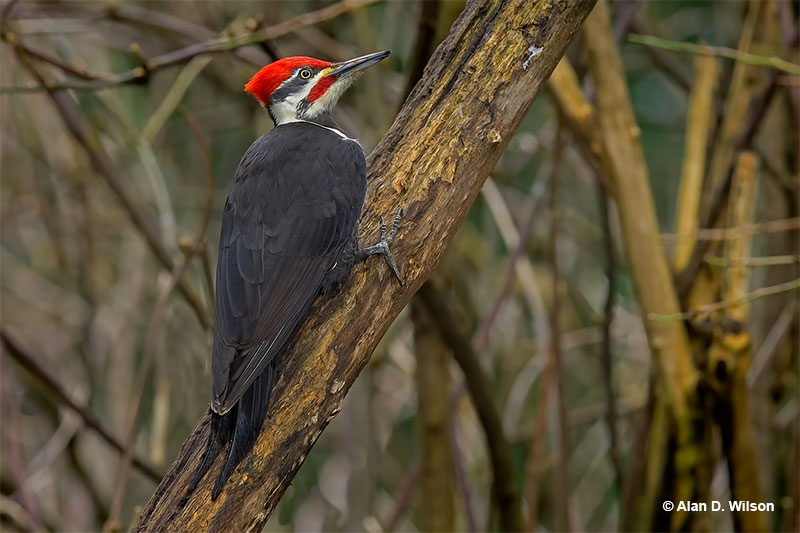
Scientific name: Dryocopus pileatus
Length: 16.5 inches
Weight: 10 ounces
Wingspan: 29 inches
Song: “kek,kek,kek,kek,kek,kek!”
The Pileated Woodpecker is a big, crow-sized woodpecker with a pointed crest. This impressive bird is mostly black but has thick white lines on the neck and face, and a big white patch under the wing.
In flight, we can also see a white patch in its primaries. The male Pileated Woodpecker has red extending from above the bill to the top of his head and crest. He also has a red moustache mark. The female only has red on her crest but both sexes have long, black and white pointed tails.
This big woodpecker uses its dark beak to peck into dead wood. In its search for ants and beetle larvae, it excavates big, rectangular-shaped holes. Although it can forage high overhead, Pileated Woodpeckers often peck into stumps and logs.
The Pileated Woodpecker is a common bird of mature woods and forest and even visits feeders in some parts of its range.
Key Identifications:
- Big, black, crested woodpecker with some red on its head, and black and white on its face, neck, and underwings.
- Pecks into wood to feeds on ants and other insects.
- Nests in tree cavities in mature forests.
- The Pileated Woodpecker makes a loud, repetitive laughing sound, “kek,kek,kek,kek,kek,kek!”.
Hairy Woodpecker
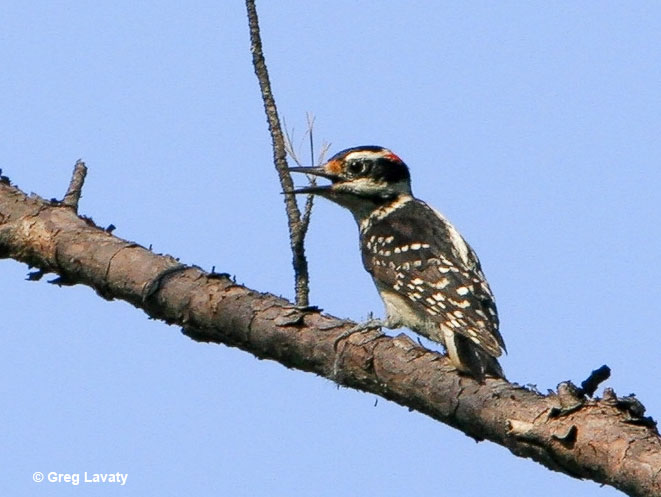
Hairy Woodpecker
The Hairy Woodpecker is a medium-sized, black and white woodpecker with a long, straight black beak. It is white below and has all white, unmarked outer tail feathers. Male Hairy Woodpeckers can be recognized by the small red patch on the back of their head. Females look just like males but lack this red patch.
We can tell this bird from the very similar Downy Woodpecker by its longer beak, sharper call, and white outer tail feathers. It feeds on beetle larvae and insects that it finds after pecking into the bark of mature trees. Unlike the Downy Woodpecker, this species only occurs in woodlands with older trees and avoids second growth.
It can visit feeders but only when they are in areas with mature woodlands and plenty of big trees. Hairy Woodpeckers are common woodpeckers and pretty easy to see in suitable habitat. As with other woodpeckers, we sometimes find them when they peck or drum on dead branches.
Red-headed Woodpecker

© Susan Young
The Red-headed Woodpecker is a medium-sized, striking woodpecker with a red velvet head and snow-white underparts. Males and females look the same and have a glossy black back, and long wings with a big white patch.
This beautiful woodpecker also has a white rump and a straight, pointed, gray beak. Young birds are patterned like adults but have grayish-brown heads, back, and wings.
Red-headed Woodpeckers feed on acorns, nuts, fruit, and insects. Although they do peck into wood and pick food from branches like other woodpeckers, they catch most of their insect prey like a flycatcher. In other words, they pick a nice snag or other prominent perch and fly into the air to catch bugs.
Red-headed Woodpeckers prefer semi-open habitats with tall, scattered trees. They can also occur in woodlands and are often seen in parks and on golf courses. This species does not flock together and is usually seen on its own or in pairs.
Northern Flicker
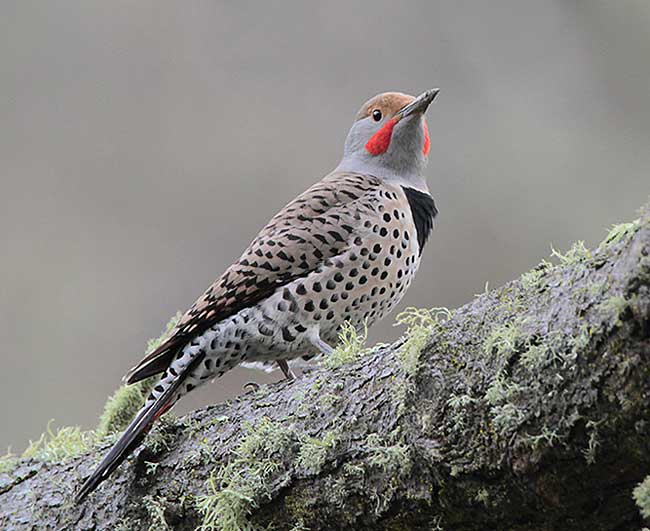
The Northern Flicker is one of the most commonly seen woodpeckers in Virginia and elsewhere. This large and unique woodpecker has a tawny face and throat, a large black mark on its breast, and black spotting on its white belly.
It also has a strong black beak, gray on the crown and back of the head and neck, and black barring on its pale brown back and wings. Males can be recognized by their black moustache mark.
In Virginia, both sexes have a small red spot on the back of the head, white rump, yellow on the underwings and a dark pointed tail. From below, their tail is yellow with a black tip.
This species mostly feeds on ants and other insects that it catches on the ground. In winter, they also eat some seeds and fruits while perched in bushes and trees. Northern Flickers live in parks, woodlands, and other semi-open places.
Keep reading: Woodpeckers in Virginia
Eagles in Virginia
Bald Eagle
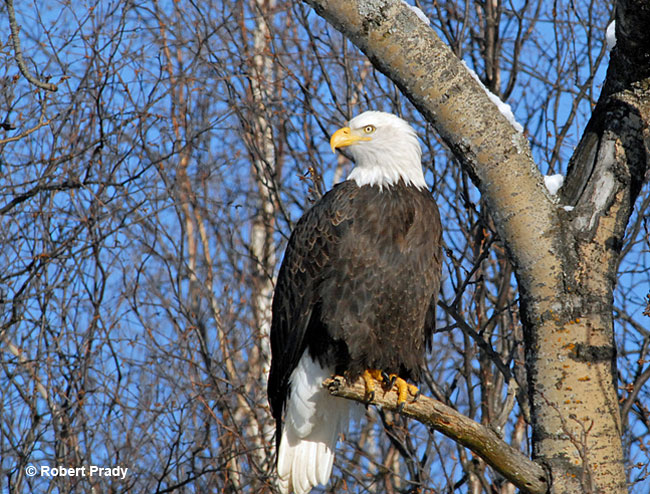
One of the biggest birds of Virginia, the Bald Eagle is a massive raptor with a dark brown body, large yellow, hooked beak, and a white head and tail. Adults are unmistakable, but young birds can be tricky to identify.
They are as large as adult Bald Eagles but don’t have white heads or tails. Instead, young eagles are mostly brown with white mottling on the underparts and in the wings and tail. They also have darker beaks.
However, they are still just as big as adults and have that same over-sized beak. When soaring, all Bald Eagles also hold their wings flat and look sort of like a big, flying plank.
Bald Eagles feed on fish, carrion, and other animals. They catch fish by snatching them from water, and catch animals by swooping down and grasping them with their powerful talons.
The Bald Eagle lives around lakes, rivers, coastal areas, and other wooded wetlands.
Hummingbirds in Virginia
Ruby-throated Hummingbird
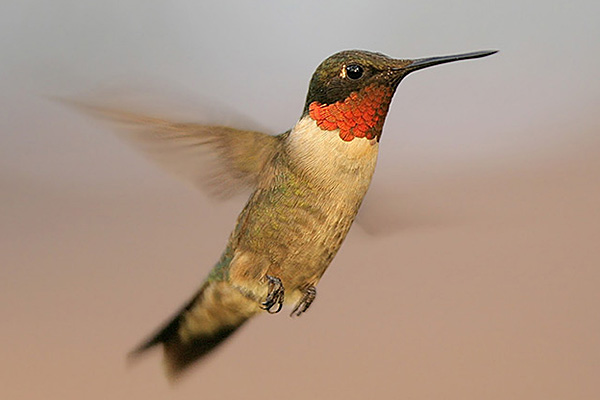
Photograph © Greg Lavaty.
The Ruby-throated Hummingbird is the smallest bird in Virginia. In much of its range, this tiny bird is unmistakable and the only regular hummingbird species. Males have iridescent green upperparts, a small white spot behind the eye, a white semi-collar, and a ruby-red throat.
They also have a dark chin, a forked, black tail, and dull greenish underparts. Females lack the red throat, are paler below, and have some black and white in their tail. Both sexes have a long, slightly curved, needle-like beak.
This hummingbird species takes nectar from a variety of small flowers and also catches small insects in flight. It lives in a variety of wooded habitats and often visits hummingbird feeders.
At feeders and flower patches, Ruby-throated Hummingbirds frequently fight with each other over their food source. They also love to bathe in shallow water and small fountains. In fall, incredibly, these tiny birds fly to Mexico and Central America for the winter.
Rufous Hummingbird
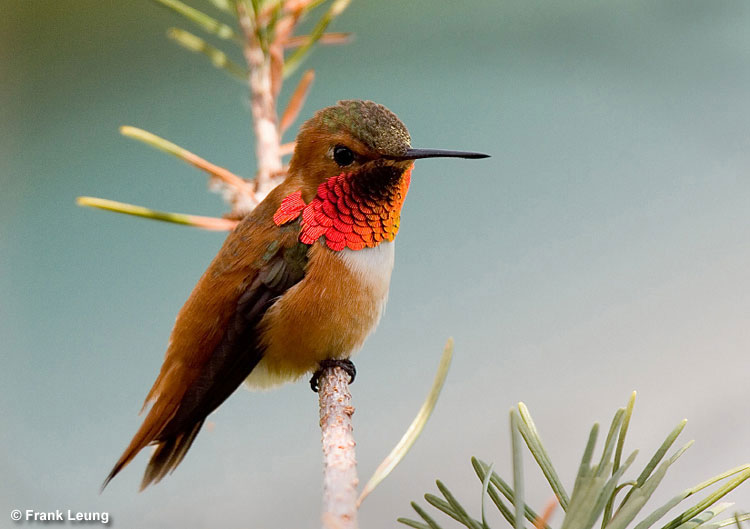
The Rufous Hummingbird is a tiny bird around the same size as the Ruby-throated Hummingbird. Like that bird species, it has a long, needle-like beak and small spot behind the eye. However, it has reddish-brown in its tail and on its underparts.
Male Rufous Hummingbirds can be rufous-brown or green above and are rufous and white below. They have a metallic, copper-orange and green throat, and a mostly rufous tail.
Females are paler below than males but always have some brown coloration. Their tail is green and rufous with some black and white.
Rufous Hummingbirds take nectar from small flowers and also feed at hummingbird feeders. The abundance of hummingbird feeders in Virginia has resulted in more sightings of these birds in the state. Although it is still rare, it has become a regular winter visitor.
Most Rufous Hummingbirds breed in coniferous forests in northwestern North America and winter in Mexico.
Frequently Asked Questions
What bird is Virginia known for?
The Northern Cardinal. Virginia’s state bird is common and conspicuous. Virginia is also known for Bald Eagles and Snowy Egrets among other common bird species.
What is the most common sparrow in Virginia?
The House Sparrow. This common bird is often seen at feeders, and in towns, cities, and parks.
How many birds are native to Virginia?
There are 487 species on the Virginia bird list.
What are the largest birds in Virginia?
The Trumpeter Swan. This huge bird is 72 inches long and has a wingspan of more than six and a half feet. Other large birds in Virginia include the Mute Swan, American White Pelican, and the Bald Eagle.
What is the fastest bird in Virginia?
The Peregrine Falcon. When diving after prey, this fastest bird on the planet can reach speeds of 180 miles per hour.
What is the state bird of Virginia?
Virginia’s state bird is the beautiful and fierce Northern Cardinal.
Let us know in the comments which bird you see the most often in Virginia.


Jody Aston
Saturday 13th of January 2024
Western Meadowlark is Virginia's state bird? When the link is clicked, it goes to the true state bird - that of a Northern Cardinal, but someone needs to change this inaccurate statement at the bottom of this otherwise interesting site, with beautiful photographs. :)
Sam Crowe
Tuesday 16th of January 2024
Thanks for bringing our attention to this! We have fixed it now.